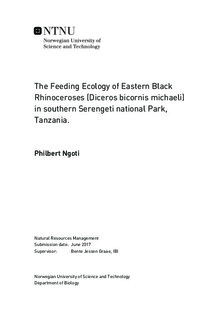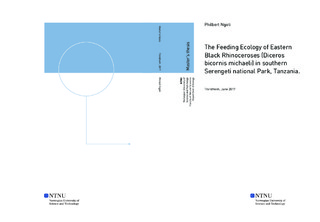| dc.description.abstract | This study has been carried out to improve the knowledge on the feeding ecology and impacts of fire on black rhinoceroses browse abundance in southern Serengeti National Park. It attempts to enlighten on forage preferences of the megaherbivore and investigate the effects of fire on abundance of their preferred vegetation species. Plant species were sampled in 64 rhino foraging plots, 300 random plots, and 198 plots with known occurrence of fire history to estimate abundances and extent of plant species browsed and the preferred species response to fire history. Additionally, a total of 15 fresh black rhinoceroses dungs were collected for DNA metabarcoding analysis to ascertain relative plant species composition of the animals diet. Across all 64 rhino foraging plots, rhinoceroses preferred 9 plant species: 5 forbs (Crotalaria barkae, Justicia betonica, Indigofera basiflora, Achyranthes aspera, Indogofera volkensii), 3 shrubs (Ziziphus abyssinica, Hibiscus species, Abutilon species), and 1 tree (Acacia sieberiana). A total of 72 taxa were identified in the rhinoceros s dung by DNA analysis, and the most important genera found are Crotalaria, Indigofera, Solanum, Euphorbia and Vachellia. The study concludes that; black rhinoceroses mainly prefer forbs; DNA metabarcoding is an efficient method to study rhino forage preference, and frequent fires may decrease preferred rhino forage. To understand the response of preferred species to fire, it is important to make manipulative studies with fire to comprehend how species grow and reproduce with and without fire. | |

